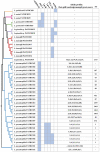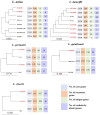Genomic characterization and assessment of pathogenic potential of Legionella spp. isolates from environmental monitoring
- PMID: 36713227
- PMCID: PMC9879626
- DOI: 10.3389/fmicb.2022.1091964
Genomic characterization and assessment of pathogenic potential of Legionella spp. isolates from environmental monitoring
Abstract
Several species in the genus Legionella are known to cause an acute pneumonia when the aerosols containing the bacteria from man-made water systems are inhaled. The disease is usually caused by Legionella pneumophila, but other species have been implicated in the infection. The disease is frequently manifested as an outbreak, which means several people are affected when exposed to the common source of Legionella contamination. Therefor environmental surveillance which includes isolation and identification of Legionella is performed routinely. However, usually no molecular or genome-based methods are employed in further characterization of the isolates during routine environmental monitoring. During several years of such monitoring, isolates from different geographical locations were collected and 39 of them were sequenced by hybrid de novo approach utilizing short and long sequencing reads. In addition, the isolates were typed by standard culture and MALDI-TOF method. The sequencing reads were assembled and annotated to produce high-quality genomes. By employing discriminatory genome typing, four potential new species in the Legionella genus were identified, which are yet to be biochemically and morphologically characterized. Moreover, functional annotations concerning virulence and antimicrobial resistance were performed on the sequenced genomes. The study contributes to the knowledge on little-known non-pneumophila species present in man-made water systems and establishes support for future genetic relatedness studies as well as understanding of their pathogenic potential.
Keywords: Legionella; environmental monitoring; novel species; virulence factors; whole-genome sequencing.
Copyright © 2023 Svetlicic, Jaén-Luchoro, Klobucar, Jers, Kazazic, Franjevic, Klobucar, Shelton and Mijakovic.
Conflict of interest statement
RK and BS were employed by company PathCon Laboratories EU. The remaining authors declare that the research was conducted in the absence of any commercial or financial relationships that could be construed as a potential conflict of interest.
Figures




References
LinkOut - more resources
Full Text Sources
Miscellaneous

